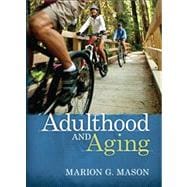
Note: Supplemental materials are not guaranteed with Rental or Used book purchases.
Purchase Benefits
Looking to rent a book? Rent Adulthood & Aging [ISBN: 9780205433513] for the semester, quarter, and short term or search our site for other textbooks by Mason, Marion G.. Renting a textbook can save you up to 90% from the cost of buying.
The reader will notice a chronological theme to the chapters, integrated research discussions, and opportunities for critical thinking through the text. The Table of Contents provides a good overview of the content and primary themes found in this text.
Table of Contents
Chapter 1: Developmental Psychology Applied To Aging: Introduces the major themes of the multidisciplinary and multifaceted nature of the field, the primary theoretical approaches, and an introduction to the scientific basis of the study
Chapter 2: Individual and Multicultural Differences: Lays the foundation for the continued discussion of individual and group differences, particularly in the areas of culture, ethnicity, age and ageism, gender, religion, and intra-individual differences
Chapter 3: Healthy Lifestyles and Successful Aging: Aimed at prevention and physically aging well, this chapter is focused on best practices and common challenges to healthy lifestyles
Chapter 4: Identity Development and Personality: Emphasizing the growth pattern of continually reshaping our identities across adulthood, this chapter explores themes related to Erikson’s developmental view and the influence of personality factors on aging
Chapter 5: Friendships and Love Relationships: Beginning with friendships, this chapter explores love relationships and lifestyle choices, such as cohabiting and marriage, along with separation and divorce
Chapter 6: Families, Generations, and Communities: Continuing the themes of the previous chapter, here the discussion shifts to parenting, grandparenting, family role transitions, and living arrangements across adulthood
Chapter 7: Education, Careers and Retirement: Emphasizing the changing nature of education and work, this chapter is focused on education, jobs and careers, retirement, and the economic issues surrounding aging
Chapter 8: Memory and Basic Cognition: Relying on the foundations laid in neuroscience and cognitive psychology, this chapter introduces the topics of brain imaging, memory models and basic cognitive performance
Chapter 9: Complex Cognition: Building on the previous chapter, the focus here is on higher-order cognitive processing, including intelligence, creativity, everyday problem solving, and reasoning about moral and ethical dilemmas
Chapter 10: Typical Physical Aging: The purpose of this chapter is to explore the areas of expected change, distinct from pathological change, by exploring changes in appearance, sensory systems, body systems, and sexuality with age
Chapter 11: Disease, Illness, and Disorders: Here the discussion shifts to the more common physical illnesses and psychological disorders found among middle age and older adults, while at the same time balancing these trends with group and individual differences
Chapter 12: Coping and Support In Late Adulthood: Emphasizing coping strategies throughout, this discussion explores adaptive technologies, the importance of social support, and the role of religious and personal outlook in quality of life during late adulthood
Chapter 13: Dying, Death, and Bereavement: Beginning with end-of-life decisions, this chapter is focused on the transitions required when death is near and when it occurs, not only of the one who is dying but also those experiencing loss and grief
Chapter 14: Life Satisfaction: The final chapter serves as a gathering place of “lessons learned” by exploring areas of self-concept, wisdom, subjective well-being, and regrets across adulthood.
The New copy of this book will include any supplemental materials advertised. Please check the title of the book to determine if it should include any access cards, study guides, lab manuals, CDs, etc.
The Used, Rental and eBook copies of this book are not guaranteed to include any supplemental materials. Typically, only the book itself is included. This is true even if the title states it includes any access cards, study guides, lab manuals, CDs, etc.